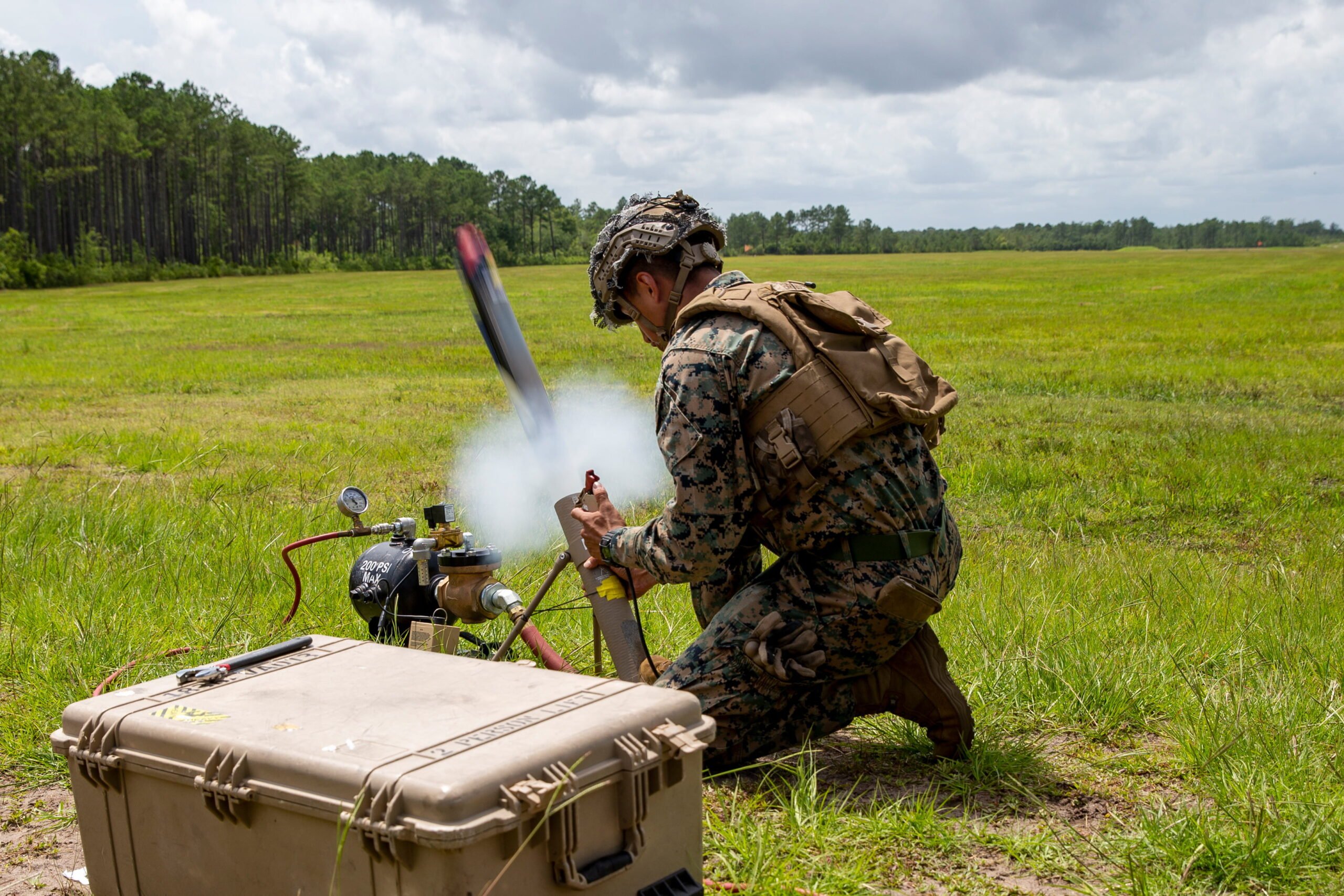Russia's war in Ukraine is becoming a testing ground for loitering ammunition. How is artificial intelligence changing the future of military deterrence?
The Russian attack on Ukraine shows that wars of conquest are not an artifact of the past. This reversion to an outdated notion of territorial integrity of states, visible since 2014 at the latest, puts the concept of deterrence back on the political agenda of many democracies.
The new German government now wants to make the contribution to NATO that the then U.S. President Donald Trump, for example, demanded with media attention a few years ago. With the special budget of 100 billion euros, Germany will probably slide into third place among the countries with the highest military spending worldwide.
Politicians and the public are still arguing about whether it's about equipment or armaments, what procurement reforms are needed and whether the F35 fighter jet should replace the Tornado and ensure nuclear sharing. But the budget and the commitment to spend two percent of GDP on defense in the future and the release of arms deliveries to an area of conflict represent a historic policy shift.
Autonomy as part of deterrence
Germany's nuclear sharing is part of NATO's nuclear deterrent. It is intended to prevent war with other major powers. Historically, the defense alliance thus at least contributed to the territorial integrity of its member states. But what do states do without direct NATO support?
Ukrainian President Volodymyr Selenskyj took office in 2019, five years after the first Russian invasion. He invested a lot of time and money in expanding Ukraine's armed forces and cooperating with Western partners to prevent a possible Russian attack.
"He was one of the few leaders on the European continent who understood that you can’t deter expansionist dictatorships using mean words or moving money around, that it could only be deterred through credible threat of force. That was not a popular opinion among his allies at the time," says, for example, Palmer Luckey, CEO of Anduril, a defense company specializing in AI solutions.
The company secured a billion-dollar contract for drone countermeasures in early 2022 and is working with NATO in Europe.
According to Luckey, it takes strong technology to drive up the cost of invasion to the point where it becomes unthinkable. Autonomy is such an important component of deterrence, he said. Modern AI technology should thus provide security to states that do not possess nuclear weapons.
In fact, Ukrainian forces use drones such as Turkey's Bayraktar TB-2, which has autonomous capabilities. However, these drones are large, with a wingspan of twelve meters, and are operated from air bases that are the target of Russian attacks. Ukraine also possessed at most 20 of those Turkish drones at the start of the war.
Ukraine uses complementary civilian drones to scout and attack Russian vehicles and infantry. Images show drones using improvised mechanisms to drop explosive devices like hand grenades on enemy troops.
But these rudimentary autonomous warfare devices are apparently not perceived by Russia as a sufficient threat, in part because the TB-2 drones are actually considered easy targets for Russian air defense systems.
Territorial forces as a mainstay of deterrence
In contrast, an established component of the deterrence strategy is the will of the population to fight the invaders. In countries such as Poland, Estonia and Ukraine, where the threat of a Russian attack had been taken seriously for years, "territorial forces" therefore emerged. They are composed of active and former military personnel and, to a large extent, volunteers from the civilian population.
The Ukrainian Territorial Armed Forces emerged in 2014 and comprise about 200,000 servicemen and women who defend various regions and Kyiv in 25 brigades.
The civilian volunteers are trained by military officers and, in the event of an invasion, are expected to combat hybrid warfare, such as that used by the Russian side in the 2014 invasion of Crimea, and engage in asymmetric warfare themselves. The ideal is small, powerful groups that can operate autonomously behind the first wave of attacks and attack the logistics chain, for example.
But will alone is not enough, says Admiral Lee Hsi-ming, former Taiwanese chief of general staff, former vice minister of national defense, and commander of the Taiwan Navy.
"Deterrence rests on the strongest possible foundations when a people’s willingness to fight is matched by its ability to do so in a way that credibly threatens a would-be invader with unacceptable costs and pain," says the retired admiral.
In Ukraine, helmets and bulletproof vests were lacking, but even more advanced weapons systems were too scarce to enter the Kremlin's reckoning. Properly equipped, territorial forces might not repel a large-scale invasion.
However, they could prevent a quick victory by ensuring that the subsequent occupation is violent and protracted, Lee said. If that does not act as a deterrent, international support can still be mobilized and time bought for outside forces to intervene.
The information war and loitering munitions.
Lee also calls for such forces for Taiwan to prevent a possible Chinese war of conquest. Territorial forces would need to be trained in the use of various weapons systems, including the Javelin, NLAW, and Stinger missiles successfully deployed in Ukraine, and, most importantly, adequately equipped before a conflict.
Access to satellite communications and training in propaganda, social media, and information operations will also prove useful, he said. Finally, Mao himself reminded us that the printing press was the guerrillas' most important weapon.
Information warfare also plays a major role in Ukraine. In the AI context, a possible Zelenskyy deepfake emerged in mid-March, disseminated via a hacked news site and intended to weaken Ukrainian troop morale in a big way. However, the Ukrainian government had already warned the population about this possible attack in early March - and the deepfake was badly done.
Elemental to the military's ability, according to Lee, are drones, particularly "loitering munitions," a combined surveillance drone and explosive device. This has proven its effectiveness - also in Ukraine - and is therefore also essential for territorial defense, according to Lee.
U.S. to supply "Switchblade" drones to Ukraine
The U.S. government agrees. "Suicide drones" have existed for at least a decade. They have been used by U.S. forces in the wars in Afghanistan and Syria, for example. The technology took a central role in last year's conflict between Armenia and Azerbaijan.
Nicholas Grossman, a professor of international relations at the University of Illinois, sees the proliferation of this type of drone as the "democratization of smart bombs." Cheap loitering munitions meant spreading smart bombs, he said. As a result, he says, the gap between advanced and smaller military powers is shrinking.
Consistently, these drones are also being used in Ukraine: the Russian army, for example, uses the ZALA KYB drone and has other models known from the Syrian conflict. The Ukrainian army has combined the domestically developed Punisher drone with a scout drone to drop bombs specifically on targets.
#Ukraine: The first proof of loitering munitions combat use by the Russian army. ZALA KYB "kamikaze" UAV fell down in #Kyiv
today.
The drone didn't explode, however it is unknown if it malfunctioned or it was downed using Ukrainian electronic warfare systems. pic.twitter.com/Ju38t0Qhrp- ?? Ukraine Weapons Tracker (@UAWeapons) March 12, 2022
However, the confirmed delivery of 100 "Switchblade" drones by the USA to Ukraine now heralds a new quality of engineered warfare. It is the first time that such a large quantity of suicide drones has been delivered to a crisis area. Apart from the USA, only the British Armed Forces are in possession of the relatively unknown drone so far.
The loitering munitions are known to come in two variants: One variant is used to combat infantry and unarmored vehicles. The second, larger variant is used against armored vehicles.
For the time being, the U.S. is probably supplying the former variant, which is so small that it fits in a backpack, including the launcher. These systems can quickly improve Ukrainian combat capability without much logistical effort or vulnerability to Russian attack.
The war with loitering munitions has just begun
According to military analysts, these drones provide Ukraine with a robust capability to attack Russian forces from the air, especially if those forces are on roads, concentrated around Ukrainian cities, or advancing into urban areas.
However, they expect the 100 Switchblades to be depleted in just a few days. They call for systematically equipping Ukrainian forces with loitering munitions, including larger Switchblade variants capable of taking out tanks and Turkish-, Australian-, or Polish-made drones.
"If these weapons aren't already being sent en masse to Ukraine, they should be," said military analysts Ryan Brobst and Bradley Bowman.
These drones could then also get into the hands of territorial forces, combining the defensive capabilities Lee calls for with the Ukrainians' will to fight. Widespread use of the relatively inexpensive drones could inflict massive damage on Russia's army and logistics.
Autonomous Weapons: The future of deterrence
Artificial Intelligence is expected to play a major role in the militaries of major powers in the future, from autonomous fighter jets to real-time information for soldiers in the field to cyberwarfare. These developments will create a new generation of weapons and change wars.
Already, the potential of relatively simple autonomy for wars of aggression and deterrence is becoming apparent. The war in Ukraine is also a test of these technologies. Other nations will learn from it.
Loitering munitions and more advanced AI weapons under development could thus become the means of choice in the future for precisely those nations that do not have nuclear weapons or nuclear sharing for deterrence.
The war in Ukraine suggests three conclusions:
- The age of wars of conquest is not over.
- Autonomous weapons are becoming an important part of deterrence.
- And the dream of a world without killer robots is thus over.
These conclusions, in turn, make it clear why the UN experts on autonomous weapons have not reached a conclusion after years of discussion: A ban on "killer robots" may be morally obvious. However, it would probably be ineffective, since such war devices have been in use for a long time, are being further developed and are gaining importance in the context of deterrence.
In early March, Australia, Canada, Japan, the Republic of Korea, the United Kingdom, and the United States submitted for consideration a regulatory proposal titled "Principles and Good Practices on Emerging Technologies in the Area of Lethal Autonomous Weapons Systems". An effort to ban autonomous weapons sounds different.







